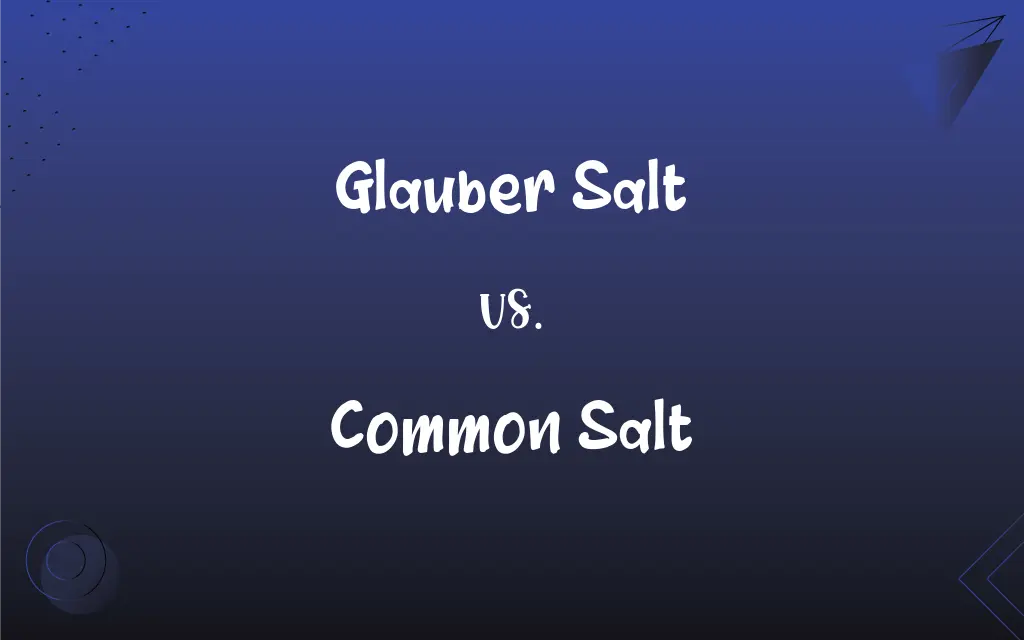Glauber Salt vs. Common Salt: What's the Difference?
Edited by Harlon Moss || By Janet White || Published on December 5, 2023
Glauber Salt is sodium sulfate (Na₂SO₄), used in detergents and dyes; Common Salt is sodium chloride (NaCl), used mainly for seasoning and preservation.

Key Differences
Glauber Salt, a crystalline solid known as sodium sulfate, is utilized in industrial applications like detergents and textile processing. Common Salt, or sodium chloride, is an essential dietary component and widely used in food seasoning and preservation.
In the chemical industry, Glauber Salt is used for its properties in drying organic liquids. Common Salt, however, is fundamental in culinary arts and also used in de-icing roads and water softening.
Glauber Salt, named after the German chemist Johann Glauber, is known for its laxative properties and is used in some medicinal preparations. Common Salt has a critical role in human physiology, including maintaining fluid balance and nerve function.
In terms of physical properties, Glauber Salt appears as white, odorless crystals and is highly soluble in water. Common Salt, also crystalline and water-soluble, is known for its distinct taste and is an integral part of everyday cuisine.
Glauber Salt can be used as a laxative and in the manufacture of glass and enamels. Common Salt, apart from its culinary uses, plays a vital role in industrial processes like chlorine and caustic soda production.
ADVERTISEMENT
Comparison Chart
Chemical Formula
Na₂SO₄
NaCl
Primary Uses
Detergents, dyes, medicinal
Seasoning, preservation, industrial
Origin of Name
Johann Glauber, a chemist
Derived from its common usage
Physical Properties
White crystals, odorless
Crystalline, salty taste
Industrial Applications
Glass manufacturing, drying liquids
Chlorine production, water softening
ADVERTISEMENT
Glauber Salt and Common Salt Definitions
Glauber Salt
A white crystalline salt used in various industrial processes.
Glauber Salt was added to the dye bath for fabric coloring.
Common Salt
Sodium chloride, essential for human health and diet.
Common Salt is a vital part of our daily dietary intake.
Glauber Salt
A compound used medicinally as a laxative.
Glauber Salt was prescribed for its laxative effects.
Common Salt
A key ingredient in the food industry for seasoning and curing.
The meat was cured using a generous amount of Common Salt.
Glauber Salt
Sodium sulfate, known for its high solubility in water.
The laboratory used Glauber Salt in their chemical experiments.
Common Salt
A white crystalline substance, widely used in cooking and preservation.
Common Salt was used to enhance the flavor of the dish.
Glauber Salt
A salt used in the manufacture of textiles and glass.
The glass industry commonly utilizes Glauber Salt in its production process.
Common Salt
A naturally occurring mineral, essential in various industrial processes.
The chemical industry utilizes Common Salt in numerous applications.
Glauber Salt
An inorganic salt with applications in the detergent industry.
Glauber Salt is a key ingredient in some detergent formulations.
Common Salt
A compound used in de-icing roads and water softening.
Common Salt was spread on the roads to melt the ice.
FAQs
What is Glauber Salt?
Glauber Salt is sodium sulfate, used in industries like detergents and textiles.
What is the main use of Common Salt?
Common Salt is mainly used for seasoning food and in food preservation.
Is Common Salt essential for health?
Yes, it plays a crucial role in maintaining fluid balance and nerve function.
What are the industrial uses of Common Salt?
It's used in chlorine production, water softening, and as a de-icing agent.
Can Glauber Salt be used in food?
No, it's primarily used in industrial applications and not suitable for food.
Can Common Salt melt ice?
Yes, it's often used to de-ice roads in winter.
Where does Glauber Salt get its name?
It's named after Johann Glauber, a German chemist who discovered it.
Is Glauber Salt used in medicine?
Yes, it's used as a laxative in some medicinal preparations.
How is Common Salt harvested?
It's obtained from sea water or mined from salt deposits.
How does Common Salt affect cooking?
It enhances flavor and can preserve foods.
What is the chemical formula of Glauber Salt?
Its chemical formula is Na₂SO₄.
Is Glauber Salt used in the textile industry?
Yes, particularly in dyeing processes.
How does Common Salt impact human health?
It's essential for bodily functions, but excessive intake can be harmful.
Can Common Salt be used in baking?
Yes, it's a common ingredient in many baked goods.
Can Glauber Salt be used in glass manufacturing?
Yes, it's used in the production of glass and enamels.
Is Common Salt used in the chemical industry?
Yes, it's crucial in the production of chlorine and caustic soda.
Is Glauber Salt harmful if ingested?
In large quantities, it can be harmful and is not meant for consumption.
How is Glauber Salt produced?
It's usually obtained as a byproduct of chemical processes.
Is Common Salt renewable?
Yes, as it's abundantly available in nature and can be replenished.
What are the physical properties of Glauber Salt?
It appears as white, odorless, highly water-soluble crystals.
About Author
Written by
Janet WhiteJanet White has been an esteemed writer and blogger for Difference Wiki. Holding a Master's degree in Science and Medical Journalism from the prestigious Boston University, she has consistently demonstrated her expertise and passion for her field. When she's not immersed in her work, Janet relishes her time exercising, delving into a good book, and cherishing moments with friends and family.
Edited by
Harlon MossHarlon is a seasoned quality moderator and accomplished content writer for Difference Wiki. An alumnus of the prestigious University of California, he earned his degree in Computer Science. Leveraging his academic background, Harlon brings a meticulous and informed perspective to his work, ensuring content accuracy and excellence.































































